12 November 2025
How to Optimize Your Amazon Listings for Discoverability in LLM Tools like ChatGPT and Gemini
TweetLinkedInShareEmailPrint Why the Next Battle for Amazon Visibility Will Be Fought in AI Search Not long a...
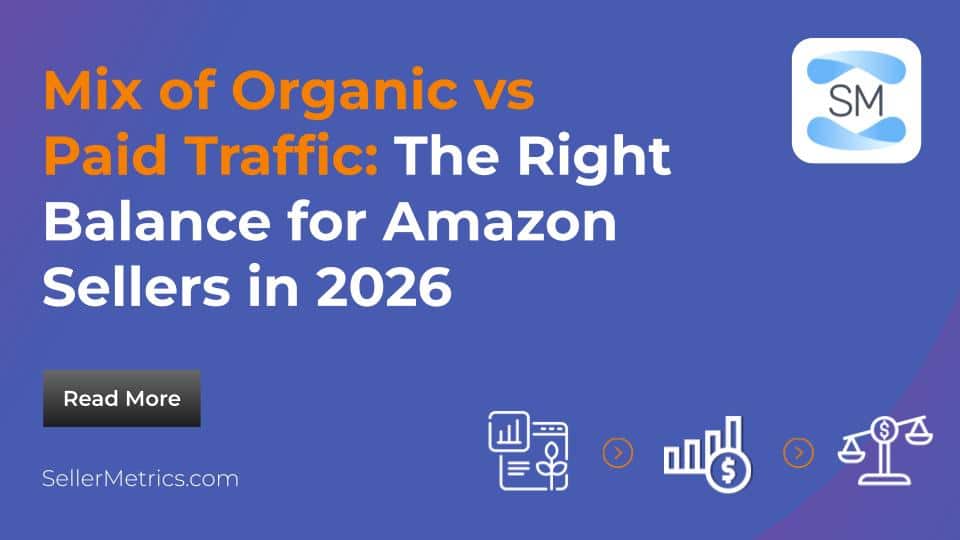
If you sell on Amazon, you already feel the tension between rising ad costs and shrinking organic visibility. The mix of organic vs paid traffic you choose will decide whether your catalogue quietly compounds profit or stays trapped in an endless cycle of ad spend that never really lets up.
This article looks at that mix specifically through an Amazon lens. We will walk through how organic and paid work inside the Amazon A9 algorithm, how the ideal balance shifts as your product matures, and which metrics actually tell you if your strategy is working. Along the way, you will see where Amazon SEO Strategy, Amazon PPC Services, and external channels fit into a single, joined-up plan.
Article of Contents
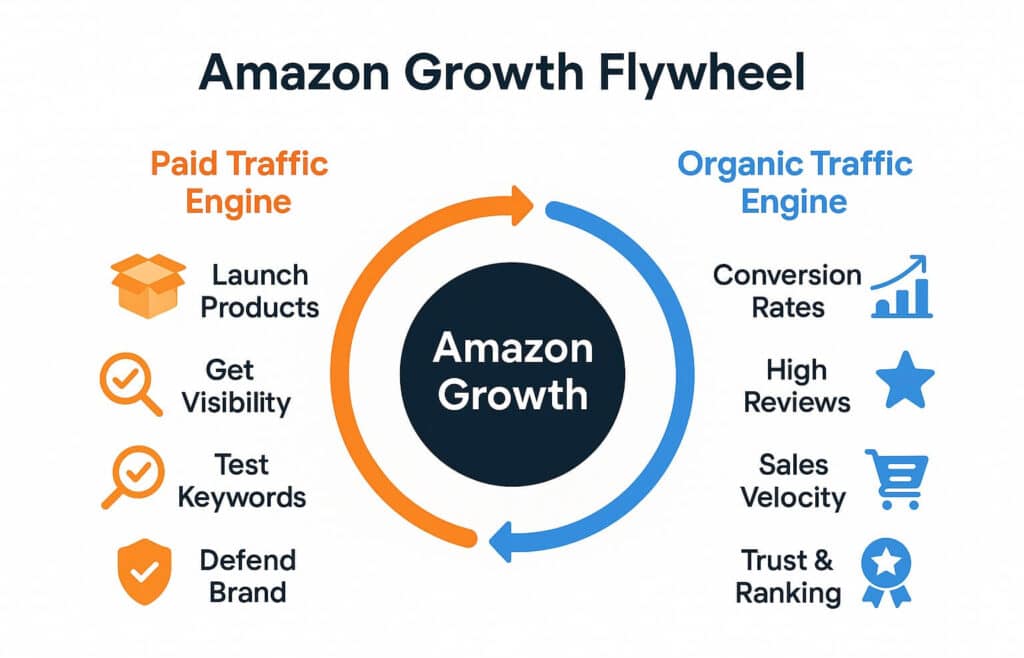
Every product on Amazon grows through two core traffic engines: organic and paid. Each engine plays a unique role and understanding how these roles connect is essential.
Organic traffic comes from earned visibility. When the Amazon A9 algorithm trusts your listing, it pushes your product onto page one for relevant keywords. This trust is built through signals such as:
Organic traffic has a compounding effect. When your listing converts well, Amazon boosts its visibility, which drives more traffic, which increases conversions, which improves rankings even further.
Organic traffic is powerful because it creates long term equity. You are not paying for visibility. You are earning it. But earning it requires momentum, and that momentum nearly always begins with paid traffic.
Paid traffic gives sellers immediate visibility. Sponsored Products, Sponsored Brands, Sponsored Display, and retargeting campaigns can push your product in front of shoppers right away.
Paid traffic helps you:
Paid traffic is quick and measurable, but temporary. When ads turn off, the traffic disappears. Relying only on ads is like renting growth instead of owning it.
The real goal is to connect both engines, so they strengthen each other. Paid traffic fuels early ranking gains. Organic traffic preserves momentum and reduces long term dependency on aggressive ad budgets.
This interconnected system is exactly why the mix of organic vs paid traffic is critical to master.
For a while, many sellers tried to play on only one side. SEO minded brands focused on optimizing listings and collecting reviews. Aggressive advertisers pushed budget into PPC and watched the short term sales roll in. Today, both extremes are risky.
A heavy, unbalanced paid focus can inflate revenue charts while quietly crushing profit. If most of your sales come from ads, any spike in CPC or change in auction dynamics can hit your cash flow overnight. The opposite extreme is just as dangerous. Relying purely on organic reach without any paid support makes it hard to gain initial visibility, especially in saturated categories.
A healthy mix of organic vs paid traffic solves both problems. Paid campaigns supply early clicks and conversions, which the Amazon A9 algorithm interprets as relevance. That relevance then supports higher organic ranking, which reduces how much you have to spend for each sale. Done well, paid and organic are not two separate strategies. They become two parts of a single engine.
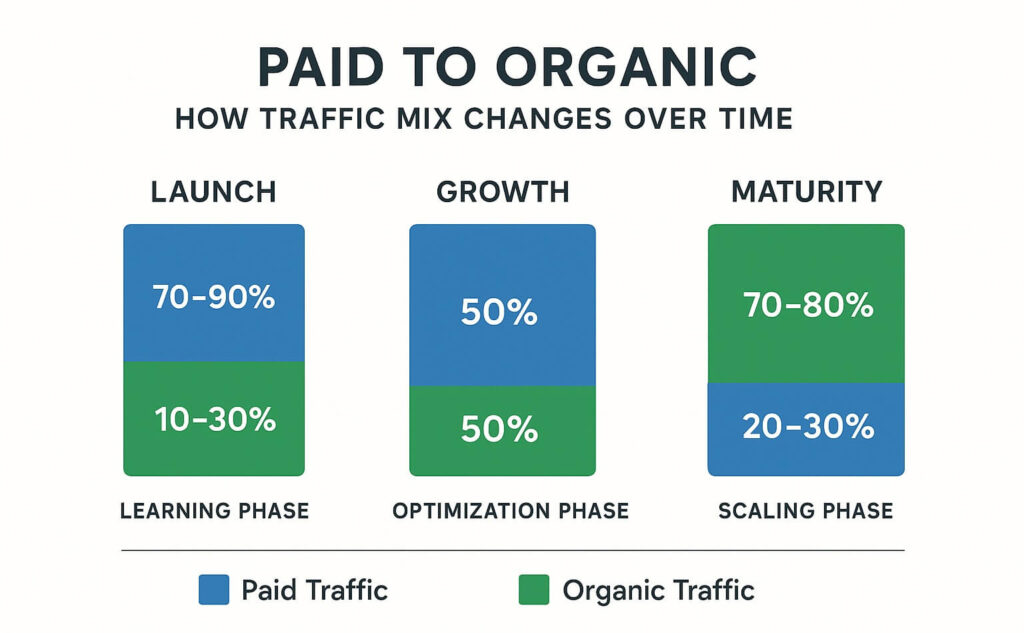
There is no one fixed percentage that works for every brand. What does stay consistent is that the right balance shifts as a product moves from launch to maturity. You can think in three stages.
When a product is new, Amazon has almost no data about it. You do not yet rank, you do not have reviews, and there is no history of conversions for relevant terms. At this point, you have to use paid traffic to get noticed.
Most successful launches accept that in the first few months the mix of organic vs paid traffic will be very skewed. It is normal for 70–90% of your sessions to be driven by ads while you prove that your product converts for priority keywords. This is where strong Amazon PPC Services, or the right Amazon PPC Software make a real difference because they help you avoid wasting those early, expensive clicks.
The goal in this phase is not maximum efficiency. It is learning. Your campaigns reveal which search terms return strong click through and conversion rates, which price points hold, and which creative variations resonate. Each high-quality conversion is a new positive signal that feeds into your long term Amazon SEO Strategy.
As reviews build and your ranking improves, organic sessions should begin to grow. More of your traffic comes from page one placements, brand store visits, and recommendations. You still rely on ads, but you no longer depend on them for every sale.
At this stage, many brands aim for something closer to a fifty–fifty split between paid and organic traffic. The mix of organic vs paid traffic becomes more strategic. You cut obvious wasted spend, tighten match types around high performing search terms, and use placements like Sponsored Brands to control more real estate on results pages where you already rank.
This is the perfect time to invest in deeper optimization. Keyword research, better images, stronger bullet points, and premium content all help lift conversion. When you combine that work with a smarter mix of organic vs paid traffic, your CPCs often drop, and your ads start to support, rather than carry, your performance.
When a product is established, the ideal picture is very different. You have built a base of reviews, proven conversion rates, and a stable ranking for your core search terms. In this mature phase, organic traffic should be the main driver of sales.
For many brands, the long-term mix of organic vs paid traffic looks closer to 70–80% organic and 20–30% paid. Ads in this phase are no longer about basic visibility. They are about defense, upselling, and testing. You protect your branded terms from competitors, highlight new variations or complementary products, and use Sponsored Display or retargeting to reconnect with warm shoppers.
This is where profitable scaling happens. Because organic performance is strong, ad impressions usually convert at a higher rate. Your blended cost of sale falls, yet your share of voice stays high.
Underneath all of this sit two key metrics: ACoS and TACoS.
In the early launch period, both ACoS and TACoS will often look high. That is acceptable if those ads are buying you the data and ranking you need. Over time, though, you want to see TACoS come down while revenue climbs. That pattern tells you that organic strength is increasing, and your mix of organic vs paid traffic is shifting the right way.
If TACoS stays flat or creeps up even though you keep optimizing campaigns, there is usually a deeper issue. It may be conversion problems on the listing, a weak offer compared with competitors, or over dependence on branded terms that do not grow your market. The numbers are not just financial metrics. They are feedback on how well your system is working.
It is easy to treat SEO and ads as separate teams, but on Amazon they constantly influence each other. Every time a paid click converts, it strengthens the relationship between your product and the search term that triggered the ad. Over time, this is one of the factors that helps you climb organically.
This is why your Amazon SEO Strategy cannot sit in isolation. You want your keyword research, content structure, and targeting decisions to be aligned. Sponsored Products campaigns should feed your understanding of search behaviour, which you then use to refine titles, bullets, and backend keywords. That refined content improves organic conversion, which then reduces your reliance on aggressive bids.
Good sellers treat Amazon SEO and PPC as a loop. Ads bring in data, data drives optimization, optimization boosts rank, and better rank improves the profitability of your ads. The strongest brands on the marketplace are usually the ones that have learned how to keep this loop running without overspending.
There is one more ingredient you cannot ignore. External traffic now plays a much bigger role in how Amazon sees your brand. When someone arrives from TikTok, YouTube, search engines, or an influencer link and then converts, that conversion still feeds your organic positioning.
This is where campaigns that focus on how to drive external traffic to Amazon become powerful. You might use Google Ads for Amazon Listings for intent driven shoppers who start their search on Google, or social campaigns that reach people earlier in the journey. With Amazon Attribution you can track which external efforts actually move the needle.
As more sellers compete aggressively inside the platform, smart use of external channels gives you another way to influence the mix of organic vs paid traffic. External visits that convert behave a lot like bonus organic signals. They can shorten the time it takes to rank and help you break away from relying solely on Sponsored Products impressions.
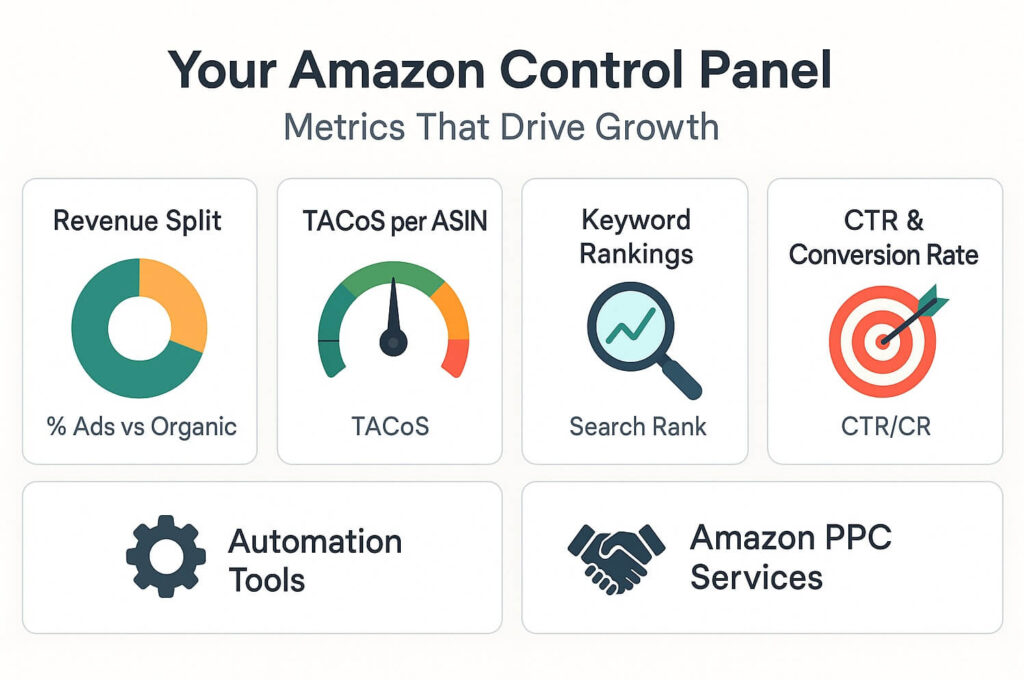
To manage all of this, you need more than raw intuition. You need a consistent process and tools that surface the right numbers.
At a minimum, you should be tracking:
Specialist platforms and Amazon PPC Software can help here by automating bid changes, surfacing wasted spend, and consolidating reporting across multiple markets. Combined with regular listing reviews and keyword audits, they give you a clear view of how to increase traffic to your Amazon listing without losing control of profit.
This is also where structured services such as Amazon PPC Services are valuable. A strong partner will not only run campaigns. They will help you continuously adjust the mix of organic vs paid traffic based on performance data, margins, and your growth goals.
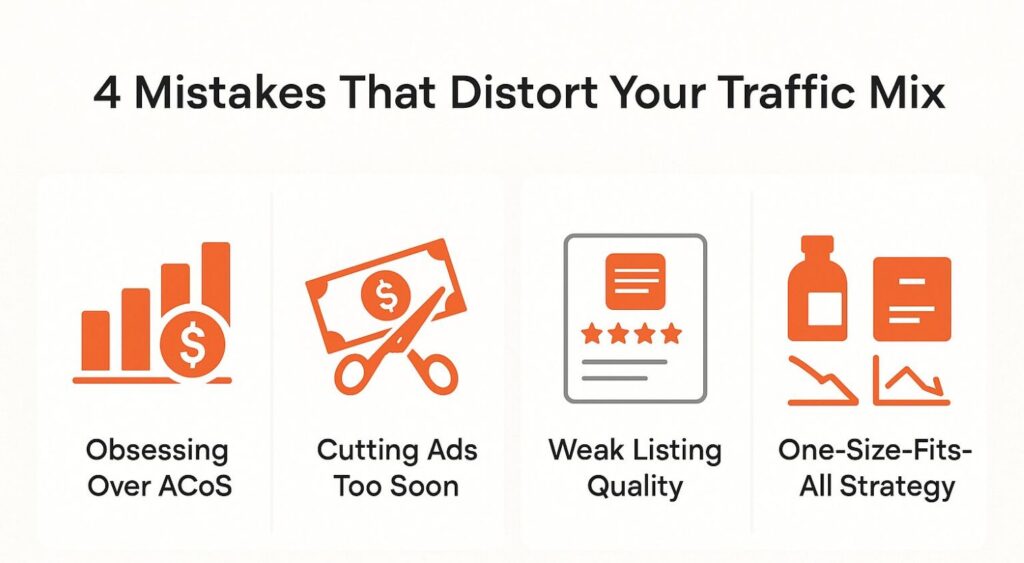
Even experienced sellers can drift into patterns that harm their long term balance. Some of the most common issues include:
Focusing only on campaign level efficiency can push you toward safe but shallow activity. You may end up bidding mostly on your brand terms, which look cheap but do little to grow reach or organic ranking.
The moment a product hits page one, it is tempting to slash spend. If you do this too aggressively, competitors can claim your placements and push you back down, forcing you to repeat the expensive launch cycle.
No amount of bidding can fix a weak listing. If your images, copy, or reviews do not convert, you will burn budget without building a sustainable base of organic sales.
Some products will always rely more on paid support because of category dynamics or margin structure. Others can move toward a heavier organic reliance. Your mix of organic vs paid traffic should reflect that reality instead of following one rule across the board.
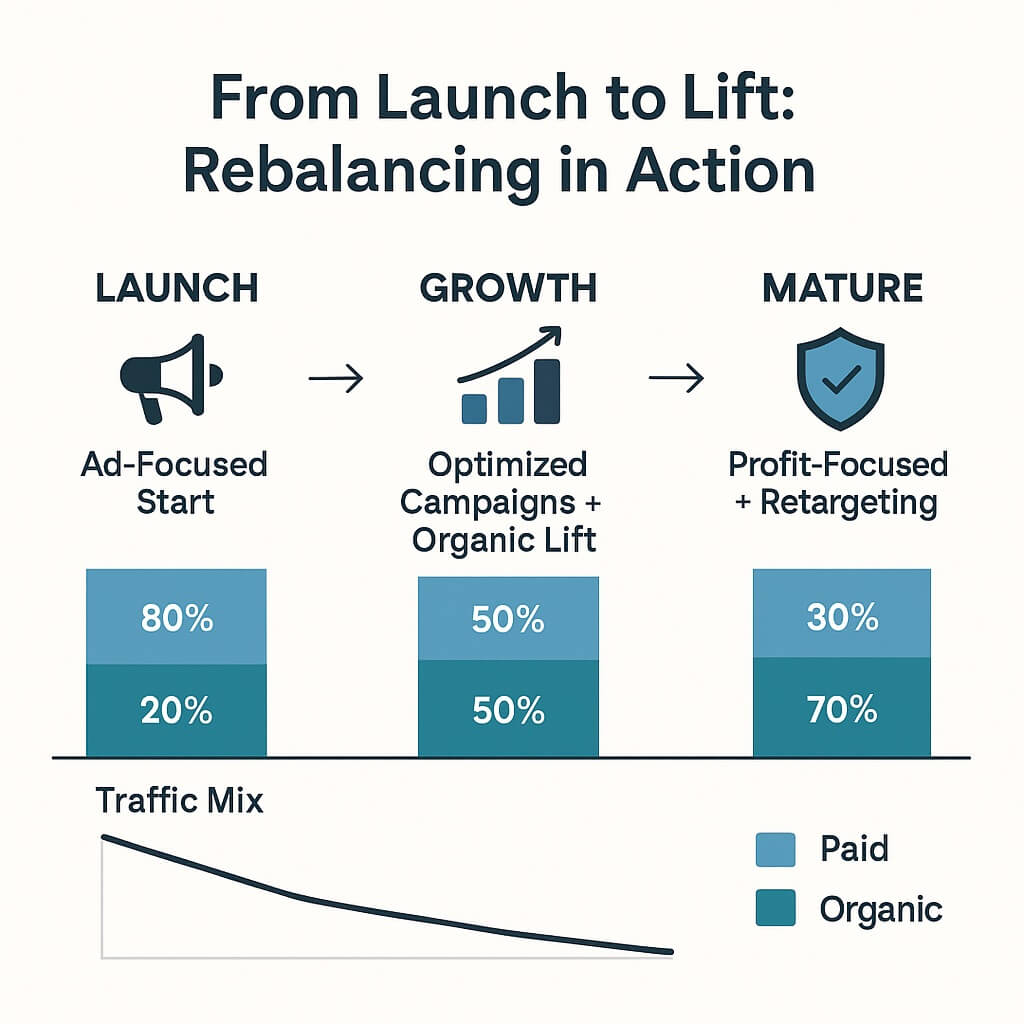
Imagine a mid sized home and kitchen brand launching a new line of organizers. For the first three months, they accept that most of their sales will come from Sponsored Products and Sponsored Brands. They focus on tightly themed campaigns, clear images, and competitive pricing to win the first wave of reviews.
By month four, their organic placements for several core search terms have improved. They use search term reports to remove low intent keywords, shift more budget into proven phrases, and refresh their A+ content to reflect what shoppers clearly care about. Organic sales rise, TACoS starts to fall, and their paid share drops to around half of total units.
Later in the year, they layer in remarketing and experiment with how to drive external traffic to Amazon through creator videos and search ads. At this point, the bulk of their volume is organic, but their ads are more profitable than ever and focused on defending their position rather than simply buying attention day by day.
Balancing all these moving parts can be hard to do manually, especially across multiple marketplaces. That is where a combination of software and expert support helps you stay ahead of both competitors and platform changes.
SellerMetrics exists to make that balance easier. With tools designed for serious advertising and visibility management, plus access to a team that understands both PPC and organic performance on Amazon, you do not have to guess your mix of organic vs paid traffic. You can measure it, test it, and improve it.
Whether you want help building a cleaner Amazon SEO Strategy, need performance-driven Amazon PPC Services, or are looking for smarter ways to use data from Amazon SEO and PPC together, you can build a more resilient growth engine when everything is under one roof.
There is no single ratio that guarantees success. What matters is that your mix of organic vs paid traffic is intentional, monitored, and adjusted as your products and categories evolve. Paid should help you launch, gather data, and defend your gains. Organic should reward that investment with durable volume and stronger margins.
If your dependency on ads falls over time while your revenue climbs, you are on the right path. If the opposite is true, it is time to reassess how you are using your budget, your listings, and your external traffic.
If you want to support designing and managing a smarter mix of organic vs paid traffic for your Amazon business, SellerMetrics can help. Book a call with the SellerMetrics team to review your current traffic breakdown, uncover wasted spend, and build a clear, data-backed roadmap for long-term Amazon growth.
A healthy balance usually shifts over time. Early on, it is normal for most of your sessions to come from ads while the algorithm learns about your product. As your rankings and reviews grow, the goal is for organic traffic to become the main driver, with paid traffic focused on defense and expansion instead of basic visibility.
In many categories, it can take three to six months before organic sessions begin to rival paid ones. It can take closer to a year for organic to clearly lead, especially in competitive niches. Your listing quality, review velocity, and how effectively you structure Amazon SEO and PPC all influence this timeline.
Paid ads do not directly change ranking, but the conversions they drive can help. When shoppers click an ad and then buy, it reinforces the relevance of your product for that search term. Over time, these signals can support better organic positions, which is why a joined up Amazon SEO Strategy and PPC plan is so important.
Start by tracking the percentage of revenue coming from ads, your TACoS, and organic rank for your most important keywords. If your ad share and TACoS decrease while total revenue and organic positions rise, your mix of organic vs paid traffic is moving in the right direction. If spend increases without clear gains in organic performance, something in your approach needs adjusting.
Yes, but for different reasons than at launch. Once you rank, ads help you protect your branded space, appear in additional placements, and support cross-selling. A smaller but carefully targeted budget will usually be enough to guard your position without rebuilding your sales every time you pause campaigns.
External channels such as search, social, and influencers can send qualified shoppers directly to your product pages. When those visitors convert, they contribute to the same sales history the algorithm uses to judge relevance. Using strategies that focus on How to drive external traffic to Amazon, supported by tracking tools, gives you another way to strengthen your organic presence over time.
Managing bids, budgets, and keywords by hand becomes difficult as your catalogue grows. Dedicated Amazon PPC Software helps you respond quickly to changes in CPC, spot wasted spend, and scale what works. Combined with regular reporting and category insights, these tools make it easier to fine tune your Mix of Organic vs Paid Traffic without losing control.
SellerMetrics brings together data, automation, and expert guidance in one place. The team can help you refine campaigns, align ads with your Amazon SEO Strategy, and uncover new ways to how to increase traffic to your Amazon listing from both inside and outside the marketplace. With a clearer view of how organic and paid work together, you can grow faster without sacrificing profitability.